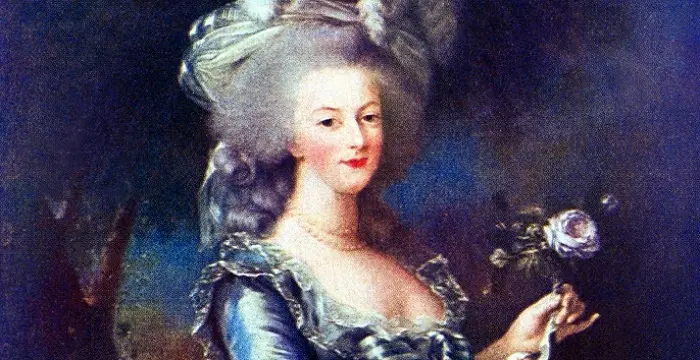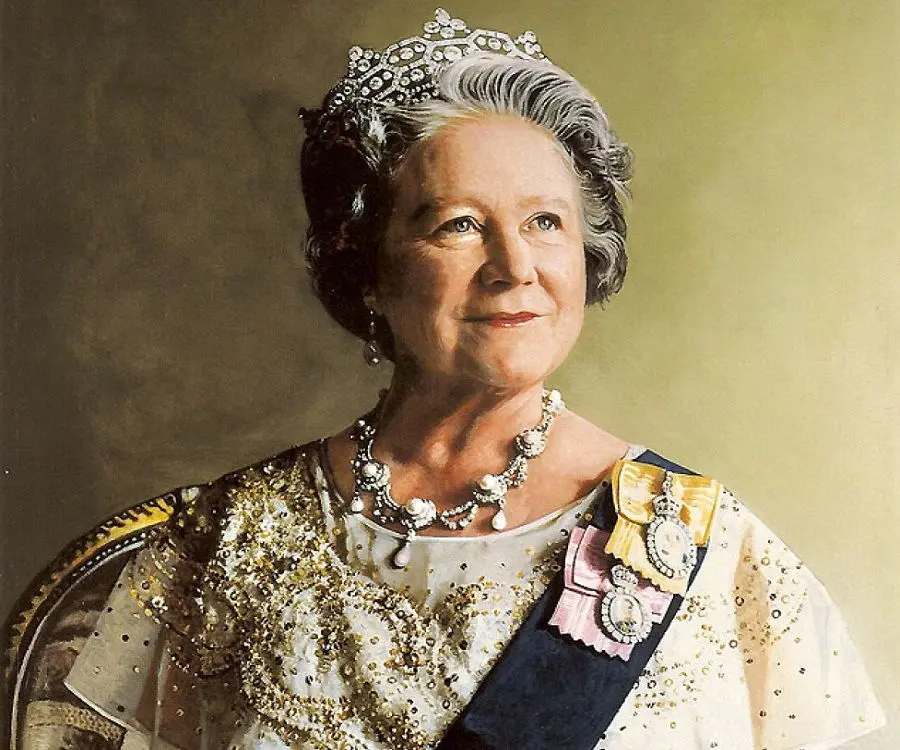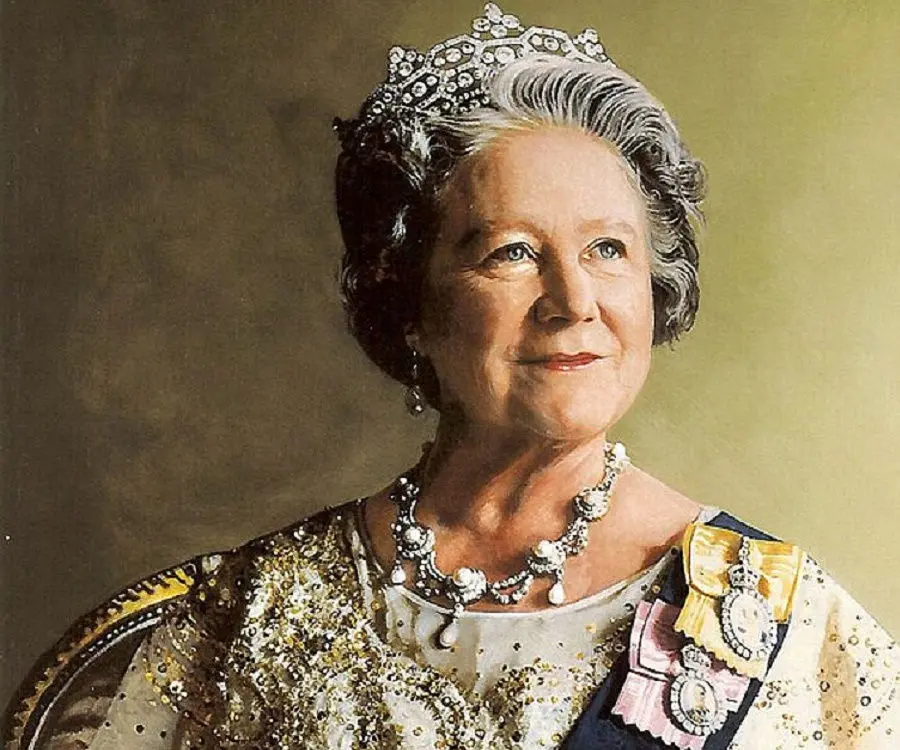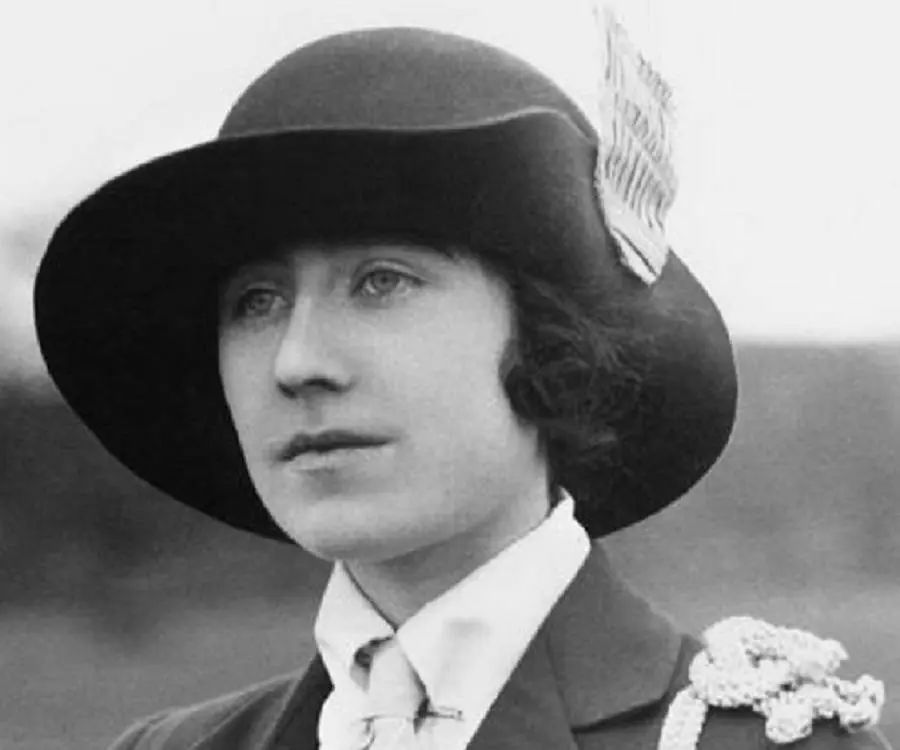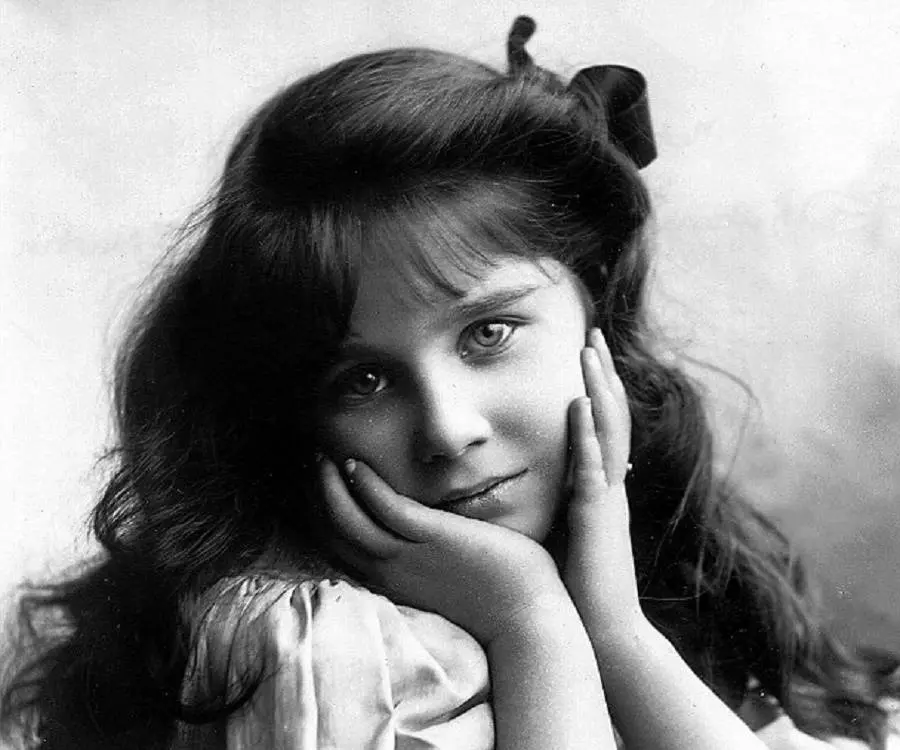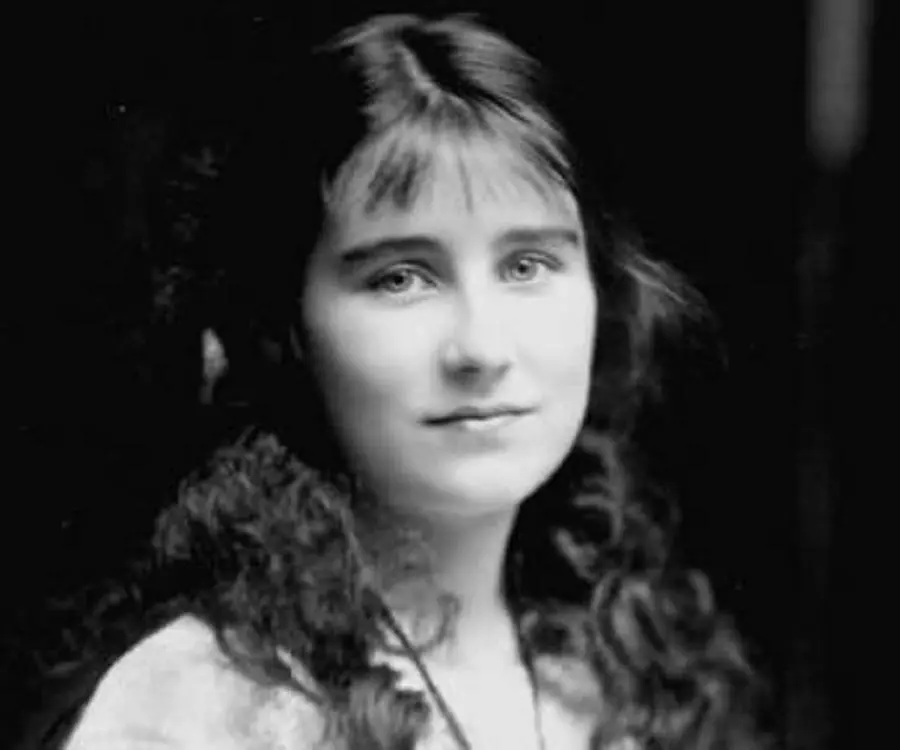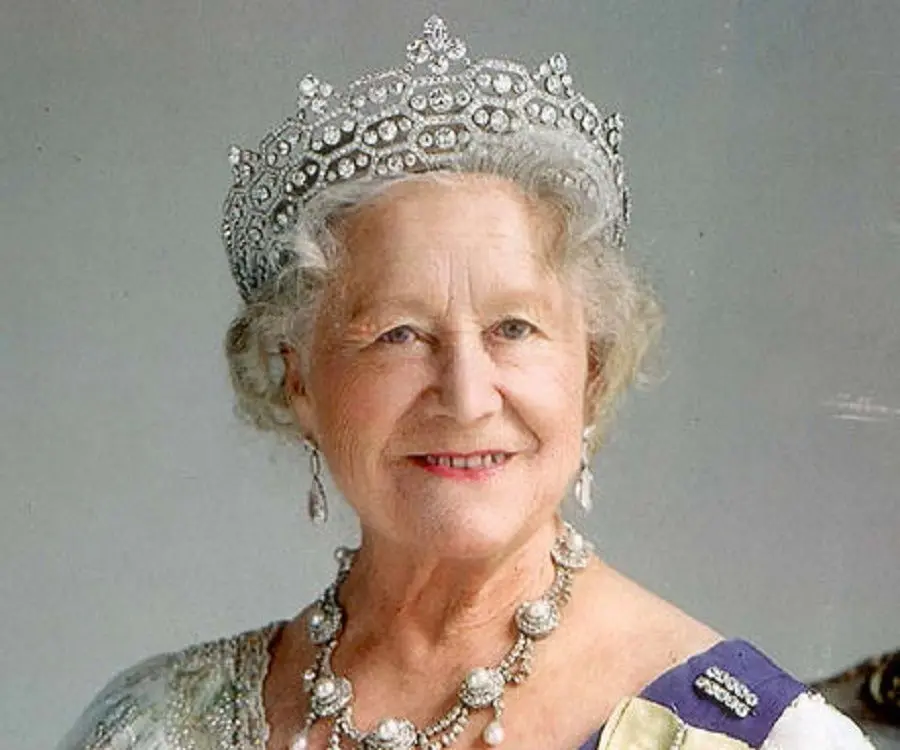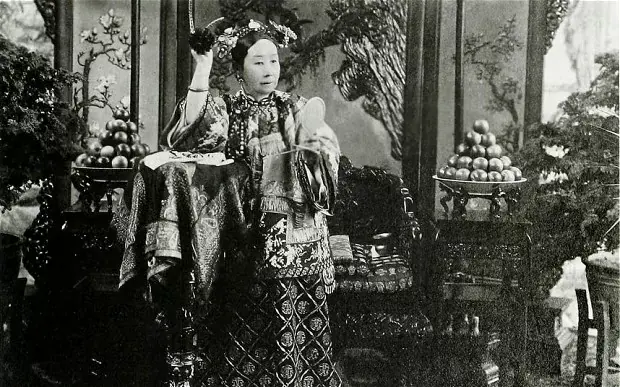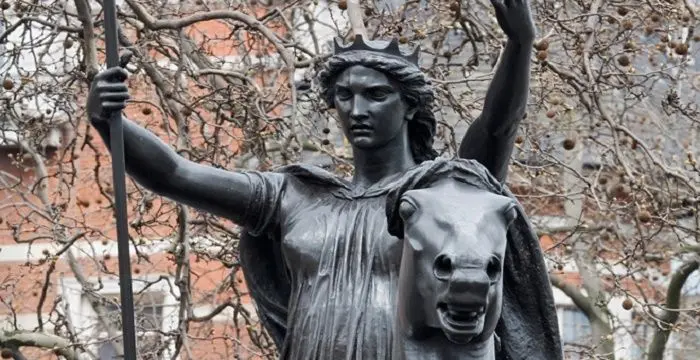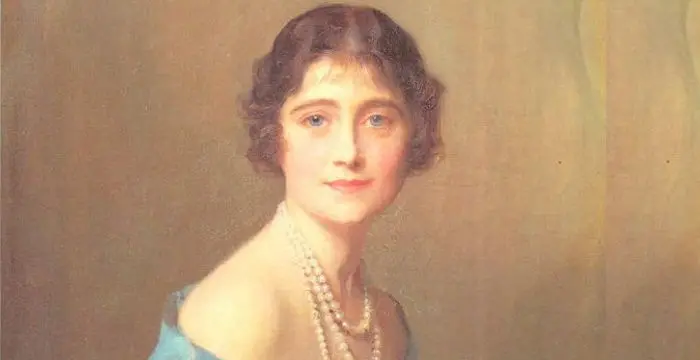
Elizabeth Bowes-Lyon - Queens, Career and Family
Elizabeth Bowes-Lyon's Personal Details
Elizabeth Bowes-Lyon was the Queen consort of the United Kingdom and the Dominions
| Information | Detail |
|---|---|
| Birthday | August 4, 1900 |
| Died on | March 30, 2002 |
| Nationality | British |
| Famous | Historical Personalities, Empresses & Queens, Empresses, Queens |
| City/State | London |
| Spouses | George VI |
| Known as | Elizabeth Angela Marguerite Bowes-Lyon, Queen Elizabeth The Queen Mother |
| Childrens | Queen Elizabeth II |
| Birth Place | Hitchin, London |
| Gender | Female |
| Father | Claude Bowes-Lyon, 14th Earl of Strathmore and Kinghorne |
| Mother | Cecilia Cavendish-Bentinck |
| Sun Sign | Leo |
| Born in | Hitchin, London |
| Famous as | British Queen |
// Famous Queens
Jetsun Pema
Jetsun Pema is the Queen consort of Bhutan. Check out this biography to know about her childhood, family life, achievements and fun facts about her life.
Princess Alice of Battenberg
Princess Andrew of Greece and Denmark, also known as Princess Victoria Alice Elizabeth Julia Marie of Battenberg, was the mother of Prince Philip, Duke of Edinburgh and mother-in-law of Queen Elizabeth II. This biography profiles her childhood, famil
Marie Antoinette
Marie Antoinette was the Queen of France and Navarre from 1774 to 1792. who played a major role in provoking the French Revolution. This biography of Marie Antoinette provides detailed information about her childhood and life
Elizabeth Bowes-Lyon's photo
Who is Elizabeth Bowes-Lyon?
Elizabeth Angela Marguerite Bowes-Lyon was the Queen consort of the United Kingdom and the Dominions from her husband King George VI’s accession in 1936 until his death in 1952 and the last empress of British India. She was the mother of the current monarch of the United Kingdom and the other Commonwealth realms, Queen Elizabeth II, as well as of Princess Margaret, Countess of Snowdon. Born and raised in British nobility, she was home-schooled by a governess until the age of eight and then started attending a school in London. At the advent of the World War I, four of her brothers enlisted in the Royal Army. Elizabeth herself contributed to the British war effort. As her family’s home, the Glamis Castle, was used as a convalescent home for wounded soldiers, Elizabeth stepped up to oversee its operation. In 1923, following her marriage to the Duke of York, Elizabeth became a prominent public figure. After King Edward VIII, her brother-in-law, abdicated the British throne in 1936 so he could marry Wallis Simpson, her husband became the new King. Elizabeth was a source of moral support for the British public during the World War II. Her husband passed away not long after the war ended and Elizabeth later came to be viewed as the matriarch of the British royal family.
// Famous Empresses
Jetsun Pema
Jetsun Pema is the Queen consort of Bhutan. Check out this biography to know about her childhood, family life, achievements and fun facts about her life.
Princess Alice of Battenberg
Princess Andrew of Greece and Denmark, also known as Princess Victoria Alice Elizabeth Julia Marie of Battenberg, was the mother of Prince Philip, Duke of Edinburgh and mother-in-law of Queen Elizabeth II. This biography profiles her childhood, famil
Marie Antoinette
Marie Antoinette was the Queen of France and Navarre from 1774 to 1792. who played a major role in provoking the French Revolution. This biography of Marie Antoinette provides detailed information about her childhood and life
Childhood & Early Life
Elizabeth was born on August 4, 1900, to Claude Bowes-Lyon, Lord Glamis (later the 14th Earl of Strathmore and Kinghorne in the Peerage of Scotland), and his wife, Cecilia Cavendish-Bentinck.
She had nine siblings and was the youngest daughter of her parents. She had six brothers: David, John, Fergus, Patrick, Michael Claude, and Alexander Francis, and three sisters, Mary, Violet and Rose.
The exact place of her birth is unknown. Some sources state that she was born in her parents' Westminster home at Belgrave Mansions, Grosvenor Gardens, while others maintain that her mother gave birth to her in a horse-drawn ambulance on her way to a nearby hospital.
Another possible location of her birth has also been proposed, the Forbes House in Ham, London, which belonged to her maternal grandmother, Louisa Scott. In the 1901 English census, Hitchin, Hertfordshire was named as her birthplace as her birth was recorded there.
Her christening took place on September 23, 1900, in the local parish church, All Saints. Her paternal aunt Lady Maud Bowes-Lyon and cousin Venetia James agreed to be her godparents.
During her youth, Elizabeth was either living at St Paul's Walden or at Glamis Castle. The latter was her family’s ancestral home. She received her early education at home from a governess and loved to participate in field sports.
After she turned eight, she enrolled at a school in London and immediately impressed her teachers by starting an essay with two Greek words from ‘Anabasis’, Greek philosopher Xenophon’s most famous work. Among the subjects she was taught at school, she especially loved literature and history.
She eventually resumed being home-schooled under a German Jewish governess named Käthe Kübler and at 13, took the Oxford Local Examination, passing it with distinction. She was 14 years old when the World War I broke out. Among her six brothers, four served in the Royal Army: Patrick, John, Fergus, and Michael. Alexander had died in 1911 and David was too young.
Fergus, who had been appointed as an officer with the Black Watch Regiment, perished during the Battle of Loos in 1915. Patrick also served in the Black Watch and after the war, he was promoted as a deputy lieutenant of Forfarshire on June 19, 1920.
John, serving with the Black Watch as well, shot himself accidentally. As a result, his left forefinger had to be amputated. Michael was captured by the German forces in 1917 and was held at a prisoner of war camp until the war ended.
Elizabeth contributed to the war effort in her own way. She helped in running the convalescent home for wounded soldiers that had been set up in Glamis. She left a significant impression on the temporary residents there. One soldier, who had received her care, wrote down in her autograph book that she should be "Hung, drawn, & quartered... Hung in diamonds, drawn in a coach and four, and quartered in the best house in the land."
Marriage & Accession
Prince Albert, Duke of York, first proposed to Elizabeth in 1921. She turned him down and later stated that it was because of her fear that she would “never, never again to be free to think, speak and act as I feel I really ought to".
Albert told his parents that he would not marry anyone else but Elizabeth. He proposed once more at his sister Princess Mary’s wedding to Viscount Lascelles on February 28, 1922, and was rejected again.
She eventually accepted his proposal in January 1923. Albert’s choice of his future bride was quite modern by contemporary standards, as royals used to marry royals from other European nations. Elizabeth, despite being the daughter of a peer, was not a member of a royal family.
The wedding took place on April 26, 1923, at Westminster Abbey. It was an unexpected affair. On her into the Abbey, she put down her bouquet at the Tomb of the Unknown Warrior, in memory of Fergus who was slain during the war.
After the wedding and the breakfast at the Buckingham Palace, the newly-married couple left to spend their honeymoon at Polesden Lacey, a palatial house in Surrey.
During the years they were the Duke and the Duchess of York, Albert and Elizabeth travelled extensively. In July 1924, they visited Ireland and from December 1924 to April 1925, they toured East Africa, visiting Aden, Kenya, Uganda, and Sudan, but not Egypt due to political unrest.
Their first child, Princess Elizabeth, was born on April 21, 1926. They welcomed their second daughter, Princess Margaret, on August 21, 1930. During their visit to Australia in 1927 to inaugurate the Parliament House in Canberra, she had to leave Princess Elizabeth behind, which made her “very miserable.”
Albert had a distinct stammer which drastically hindered his ability to speak in public gatherings. Elizabeth helped him with the speech treatment devised by Australian speech and language therapist Lionel Logue. This episode served as the inspiration for the 2010 Oscar-winning film, ‘The King’s Speech’.
Albert’s father, King George V, passed away on January 20, 1936, and Edward, Prince of Wales, being the oldest son, succeeded their father as King Edward VIII. However, he caused a constitutional crisis by being firm in his desire to marry an American divorcée, Wallis Simpson. While he was legally free to marry anyone, the Church of England did not allow remarriage of divorced people and being the King of England, he was also the head of the said church.
Eventually, Edward chose to abdicate the throne in his brother’s favour and married Simpson. Assuming the regal name “George VI”, Albert ascended the throne on December 11, 1936. Elizabeth simultaneously became the Queen Consort. George VI was crowned at Westminster Abbey on May 12, 1937.
Life as Queen Consort
George VI began his reign at a very tremulous time in history. Another world war was imminent with the rise of the Third Reich in Germany. Elizabeth accompanied her husband on his visit to France to demonstrate Anglo-French solidarity against the ever-growing threat of Nazi Germany.
The royal couple was subjected to some criticism after they invited British Prime Minister Neville Chamberlain to accompany them on the balcony of the Buckingham Palace to greet a crowd of well-wishers. Chamberlain was quite popular among the British public, but his policies concerning Nazi Germany drew opposition.
In 1939, the king and the queen embarked on a successful tour of North America, visiting Canada first and then making their way to the United States. The crowd greeted them enthusiastically everywhere they went.
If there was any residual feeling that George was a poor substitute for Edward, it mostly dissipated after the visit. In a conversation with Canadian Prime Minister William Lyon Mackenzie King, Elizabeth correctly remarked, “That tour made us.”
During the World War II, George and Elizabeth emerged as the unwavering symbols in the fight against fascism. In November 1939, ‘The Queen's Book of the Red Cross’ was published to fund the efforts of the Red Cross during the war.
She vehemently and publicly turned down the proposal for her and her children to leave London. Even when she was urged by the cabinet to do so during the Blitz, she refused, stating, “The children won't go without me. I won't leave the king. And the king will never leave.”
Her regular visits to the barracks, hospitals, and factories that had been damaged by the constant bombing by the German Luftwaffe brought her much admiration. The bombing also damaged parts of the Buckingham Palace itself.
Elizabeth received instructions on how to use a revolver, as, during the Phoney War, the British officials feared an attack could come at any time. After Chamberlin resigned in May 1940, Winston Churchill replaced him as the Prime Minister of the United Kingdom. Initially wary of Churchill’s motives, the king and the queen soon came to respect him.
According to various sources, Adolf Hitler once dubbed her “the most dangerous woman in Europe" because he believed that her immense popularity could pose a threat to German interests.
In the years after the war, she witnessed the sound defeat of the Conservative Party of Winston Churchill by Clement Attlee’s Labour Party and her husband relinquishing the title of Emperor of India in June 1948, nearly a year after the independence of India and Pakistan.
Elizabeth sought to portray a regal, serene composure throughout her life and there is only one recorded instance when it was apparently broken. During the royal visit to South Africa in 1947, she hit a man with an umbrella from the royal car after she took his ardour for malice.
Matriarch of the British Royal Family
The king’s health had been on a steady decline since the war ended. He was a heavy smoker and the immense stress of the war had its effect as well. He was subsequently diagnosed with lung cancer and other ailments, such as arteriosclerosis and Buerger's disease.
In the last few months of his reign, his oldest daughter, Elizabeth, performed most of his royal duties as the heir presumptive. George VI passed away on the morning of February 6, 1952. Elizabeth, the heir presumptive, succeeded him to the throne as Elizabeth II.
After the death of her husband, a devastated Elizabeth had retired to Scotland but Churchill visited her and convinced her to resume her public duties.
She preferred to be referred to as “Her Majesty Queen Elizabeth The Queen Mother” over the conventional style for the widowed queen, “Queen Elizabeth”, as she felt that it was not very distinguishable from the style her daughter as the Queen of the United Kingdom was using.
Accompanied by Princess Margaret, she travelled to the Federation of Rhodesia and Nyasaland to lay the foundation stone of the University College of Rhodesia and Nyasaland, which later became the University of Zimbabwe.
She also supervised the restoration of the Castle of Mey in Scotland, which often served as her refuge. While George was still alive, she found a new interest in horse racing and would be a devoted supporter and sponsor of the sport throughout the rest of her life.
Death & Legacy
In her final years, Elizabeth received a new wave of admiration for her longevity. She turned 100 years old in 2000 and the occasion was marked by a parade and the issuing of a special commemorative £20 note with her image on it.
In February 2002, Princess Margaret died of various ailments caused by her smoking. The loss of one of her children took a heavy toll on her. Elizabeth, the Queen Mother, passed away in her sleep on March 30, 2002, at the Royal Lodge, Windsor Great Park. Her only surviving daughter, Queen Elizabeth II, was right at her bedside.
Elizabeth had become a member of the royal family at a time which turned out to be a transitional period for the British Empire. The empire was dissolved completely and the Commonwealth, at least from the British point of view, was a poor substitute. New nations, such as the USA and the USSR, were on the rise.
Despite the changing international political scenario, both she and her husband, and Queen Elizabeth II after them, led the British people by example. It was her tenacity, emboldened by her inherent dignity, which has made her popularity long-lasting.
// Famous Historical Personalities
Sundiata Keita
Sundiata Keita was the founder of the Mali Empire in West Africa. This biography profiles his childhood, early life, struggles, founding of empire, rule, administration, achievements and also gives some fun facts.
Ashoka
Ashoka was the third emperor of the Mauryan Dynasty and ruled almost the entire Indian subcontinent. This biography profiles his childhood, life, reign, achievements and timeline
Jetsun Pema
Jetsun Pema is the Queen consort of Bhutan. Check out this biography to know about her childhood, family life, achievements and fun facts about her life.
Elizabeth Bowes-Lyon biography timelines
- // 1900Her christening took place on September 23, 1900, in the local parish church, All Saints. Her paternal aunt Lady Maud Bowes-Lyon and cousin Venetia James agreed to be her godparents.
- // 4th Aug 1900Elizabeth was born on August 4, 1900, to Claude Bowes-Lyon, Lord Glamis (later the 14th Earl of Strathmore and Kinghorne in the Peerage of Scotland), and his wife, Cecilia Cavendish-Bentinck.
- // 1901Another possible location of her birth has also been proposed, the Forbes House in Ham, London, which belonged to her maternal grandmother, Louisa Scott. In the 1901 English census, Hitchin, Hertfordshire was named as her birthplace as her birth was recorded there.
- // 1917John, serving with the Black Watch as well, shot himself accidentally. As a result, his left forefinger had to be amputated. Michael was captured by the German forces in 1917 and was held at a prisoner of war camp until the war ended.
- // 1920Fergus, who had been appointed as an officer with the Black Watch Regiment, perished during the Battle of Loos in 1915. Patrick also served in the Black Watch and after the war, he was promoted as a deputy lieutenant of Forfarshire on June 19, 1920.
- // 1921Prince Albert, Duke of York, first proposed to Elizabeth in 1921. She turned him down and later stated that it was because of her fear that she would “never, never again to be free to think, speak and act as I feel I really ought to".
- // 1922Albert told his parents that he would not marry anyone else but Elizabeth. He proposed once more at his sister Princess Mary’s wedding to Viscount Lascelles on February 28, 1922, and was rejected again.
- // 1923She eventually accepted his proposal in January 1923. Albert’s choice of his future bride was quite modern by contemporary standards, as royals used to marry royals from other European nations. Elizabeth, despite being the daughter of a peer, was not a member of a royal family.
- // 1926Their first child, Princess Elizabeth, was born on April 21, 1926. They welcomed their second daughter, Princess Margaret, on August 21, 1930. During their visit to Australia in 1927 to inaugurate the Parliament House in Canberra, she had to leave Princess Elizabeth behind, which made her “very miserable.”
- // 1936Albert’s father, King George V, passed away on January 20, 1936, and Edward, Prince of Wales, being the oldest son, succeeded their father as King Edward VIII. However, he caused a constitutional crisis by being firm in his desire to marry an American divorcée, Wallis Simpson. While he was legally free to marry anyone, the Church of England did not allow remarriage of divorced people and being the King of England, he was also the head of the said church.
- // 1939In 1939, the king and the queen embarked on a successful tour of North America, visiting Canada first and then making their way to the United States. The crowd greeted them enthusiastically everywhere they went.
- // 1940Elizabeth received instructions on how to use a revolver, as, during the Phoney War, the British officials feared an attack could come at any time. After Chamberlin resigned in May 1940, Winston Churchill replaced him as the Prime Minister of the United Kingdom. Initially wary of Churchill’s motives, the king and the queen soon came to respect him.
- // 1947Elizabeth sought to portray a regal, serene composure throughout her life and there is only one recorded instance when it was apparently broken. During the royal visit to South Africa in 1947, she hit a man with an umbrella from the royal car after she took his ardour for malice.
- // 1948In the years after the war, she witnessed the sound defeat of the Conservative Party of Winston Churchill by Clement Attlee’s Labour Party and her husband relinquishing the title of Emperor of India in June 1948, nearly a year after the independence of India and Pakistan.
- // 1952In the last few months of his reign, his oldest daughter, Elizabeth, performed most of his royal duties as the heir presumptive. George VI passed away on the morning of February 6, 1952. Elizabeth, the heir presumptive, succeeded him to the throne as Elizabeth II.
- // 2002In February 2002, Princess Margaret died of various ailments caused by her smoking. The loss of one of her children took a heavy toll on her. Elizabeth, the Queen Mother, passed away in her sleep on March 30, 2002, at the Royal Lodge, Windsor Great Park. Her only surviving daughter, Queen Elizabeth II, was right at her bedside.
// Famous Empresses & Queens
Jetsun Pema
Jetsun Pema is the Queen consort of Bhutan. Check out this biography to know about her childhood, family life, achievements and fun facts about her life.
Princess Alice of Battenberg
Princess Andrew of Greece and Denmark, also known as Princess Victoria Alice Elizabeth Julia Marie of Battenberg, was the mother of Prince Philip, Duke of Edinburgh and mother-in-law of Queen Elizabeth II. This biography profiles her childhood, famil
Marie Antoinette
Marie Antoinette was the Queen of France and Navarre from 1774 to 1792. who played a major role in provoking the French Revolution. This biography of Marie Antoinette provides detailed information about her childhood and life
Nefertiti
Neferneferuaten Nefertiti was an Egyptian queen and chief consort of Akhenaten, an Egyptian Pharaoh. This biography profiles her childhood, family, life as queen, accomplishments, death, and other facts.
Empress Dowager Cixi
Empress Dowager Cixi was a Chinese empress dowager and regent of the Qing Dynasty. This biography profiles her childhood, rise to power, rule, administration and other interesting facts.
Boudica
Boudica was a queen of the Celtic Icenic tribe, who led an uprising against Roman invaders. Check out this biography to know about her childhood, family, achievements, etc.
Elizabeth Bowes-Lyon's FAQ
What is Elizabeth Bowes-Lyon birthday?
Elizabeth Bowes-Lyon was born at 1900-08-04
When was Elizabeth Bowes-Lyon died?
Elizabeth Bowes-Lyon was died at 2002-03-30
Where is Elizabeth Bowes-Lyon's birth place?
Elizabeth Bowes-Lyon was born in Hitchin, London
What is Elizabeth Bowes-Lyon nationalities?
Elizabeth Bowes-Lyon's nationalities is British
Who is Elizabeth Bowes-Lyon spouses?
Elizabeth Bowes-Lyon's spouses is George VI
Who is Elizabeth Bowes-Lyon childrens?
Elizabeth Bowes-Lyon's childrens is Queen Elizabeth II
Who is Elizabeth Bowes-Lyon's father?
Elizabeth Bowes-Lyon's father is Claude Bowes-Lyon, 14th Earl of Strathmore and Kinghorne
Who is Elizabeth Bowes-Lyon's mother?
Elizabeth Bowes-Lyon's mother is Cecilia Cavendish-Bentinck
What is Elizabeth Bowes-Lyon's sun sign?
Elizabeth Bowes-Lyon is Leo
How famous is Elizabeth Bowes-Lyon?
Elizabeth Bowes-Lyon is famouse as British Queen


